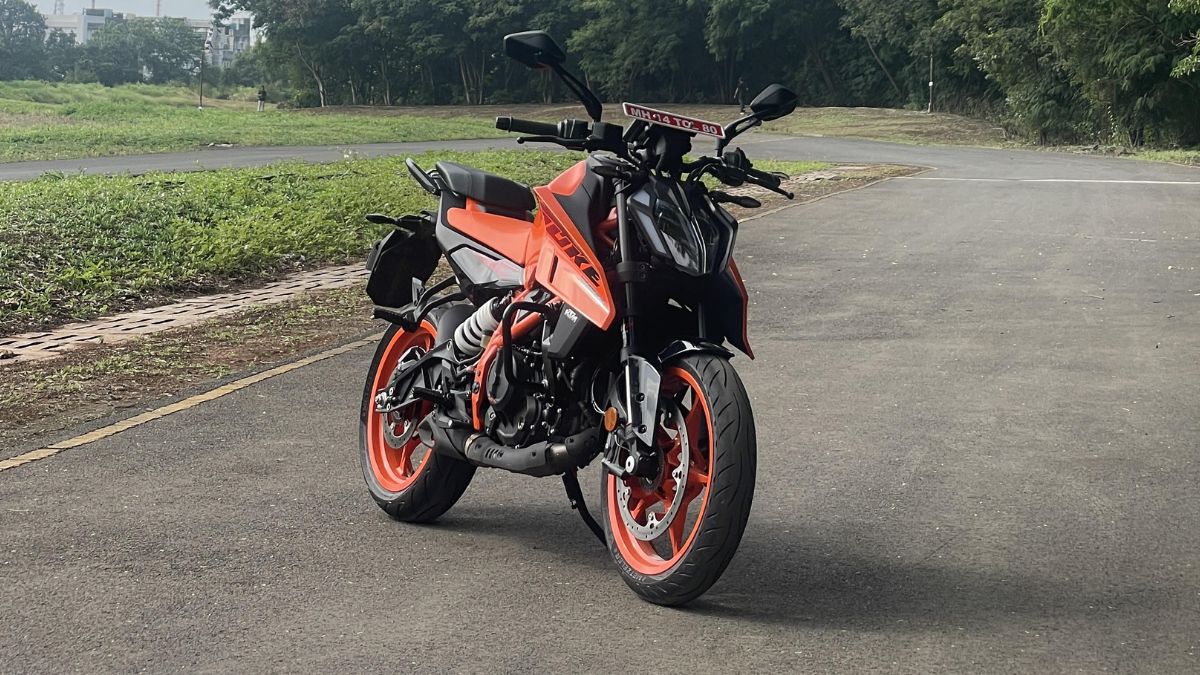- By Anirban Mitra
- Mon, 18 Sep 2023 07:49 PM (IST)
- Source:JND
I rode the new generation of a motorcycle that has taken performance and thrill to the masses. Whack the throttle open, and it’s still seriously quick. It nimbly pierces through the air, enjoying every square inch of traction available to the rubber. Aggressively scrapping the corner is still its A-game. While the intent of owning and riding a Duke 390 remains the same, KTM has changed the world inside-out of the generation 3 model. Allow me to explain how.
The heart of the matter is a new and bigger engine, nestling in a revised frame. The 399-cc, single-cylinder, liquid-cooled, DOHC, LC4c mill pumps out 46 PS and 39 Nm of peak torque. The increased power is sent to the rear wheel using a 6-speed gearbox, which is aided by a quick-shifter. The Duke 390 seems to have hit the gym, shredded some mass, and yet aesthetically appears bulked up. A healthy 4-kilo reduction is attributed to hubless rotors, a new engine and a skeleton. Effectively, the lightning-quick Duke 390 promises a better power-to-weight number.
Twist the throttle, triple digits on the new 5-inch TFT display is achieved in a blink. Sitting at 120 kmph for long hours is still effortless for the Duke 390 and given a piece of open yet controlled tarmac (like we did at Bajaj’s Chakan facility), you can touch 165 kmph in the 6th gear, redlining at 10,000 rpm. A bi-directional quick-shifter does the heavy lifting, making long-distance cruises simpler.

The LC4c engine is characteristically different from the one it replaces. The max power and peak torque kick in 500 rpm lower than earlier and a healthy power band is available 5,000 rpm onwards. This effectively means a lot of KTM owners complaining about Duke 390’s vagueness at mid-range have something to cheer about. The tractability has improved. The top-end is enjoyable as ever with the Duke 390 scrapping 10,000 rpm with ease. That said, engine refinement is still in short supply. In and around 5,000 rpm, a good amount of vibrations creep in through the handlebars, tank and footpegs, which keeps on climbing as you wring the throttle.
Duke 390 dives into the corners eagerly and urges you to scrap the knee guards at the apex and remain sure-footed. The appetite for sporting handling continues to be Duke 390’s strength. Plenty of it is due to the revised steel trellis frame, new aluminium swing arm and swingarm. The wheelbase is tighter than before and a lower seat height (800mm) ensures the rider sits commandingly on top of the motorcycle. The skeleton revision has jacked up the ground clearance (180 mm) and lowered the seat height. While tip-toeing in city traffic gets simpler, the Duke 390 is also used by many for touring purposes. For riders above 5’ 10”, this reworked ergonomics for the lower body may seem slightly painful for longer journeys.
The bite from the brakes is sharp and brings the bike to a halt with confidence. The supermoto mode allows the rider to turn off the rear ABS. There is launch control in track mode for better take-off. Hardware galore, Duke 390’s system consists of traction control, top speed limiter, cornering ABS, Bluetooth connectivity, and higher adjustable suspensions. The KYB inverted forks up front are 5-step adjustable for rebound and preload whereas the monoshock at the rear comes with 10-way preload and 5-step adjustment for rebound. The general tendency of the springs is on the softer side but there is ample room to play with. Highly stiff for track days, with few clicks and the suspension adapts for a proper highway tourer.
The KTM Duke 390 is fast but highly enjoyable if you are looking for a lightweight naked motorcycle. Taut around the corners, the safety belt tries to keep you steady. The way it rides is a dream to many and with the extra horses in its chink, Duke 390 yet again will give the market run for their money. Talking about the pricing, the third generation Duke 390 comes loaded in a singular trim at Rs 3.10 lakh (ex-showroom).

